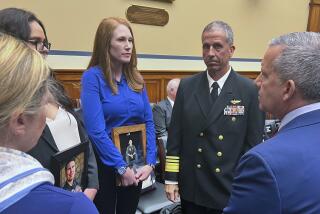Tougher Standards for Pilots Sought : Former Test Pilot Takes On the FAA Over Air Safety
Tony LeVier, a former test pilot who set flying records for two decades at the dawn of the jet age, would like to be spending his retirement days out on the golf course in La Canada.
Instead, the strapping ex-fighter jock feels compelled to battle the Federal Aviation Administration and much of the U.S. aviation establishment over what he calls inadequate skills in the nation’s airways.
“The quality of our pilots is creeping down and down,” LeVier says. “Some of these pilots are substandard in their skills, and they are finding their way into the airlines.”
LeVier has formed a nonprofit corporation--Safe Action in Flight Emergency Inc. (SAFE)--to push for more stringent FAA requirements in civilian pilot training and licensing.
The issue of air safety is generating plenty of attention these days and attracting more than a few self-styled experts. But LeVier brings to the debate an authoritative voice renowned in aviation circles.
LeVier was chief test pilot at Lockheed for more than a decade, during which he was the pilot on the first flights of such important jet aircraft as the U-2, the F-104 and the P-80. He was director of flying operations at Lockheed from 1955 to 1974.
Seeks Extra Requirement
In his 58 years of flying, LeVier says he has come to depend on his ability to pull out of flight emergencies. SAFE’s goal is approval of a federal requirement that every pilot receive emergency maneuver flight training, something that many commercial pilots surprisingly have never received.
Under current FAA regulations, pilots are taught to avoid emergencies, but they are not required to learn how to stabilize an aircraft that is out of control.
“All these people with new licenses who are ending up in commercial airliners know how to do is fly straight and level. If they get into an upset, they’ve bought the farm,” LeVier says.
“There are people flying commercial airliners who have never been upside down in an airplane. But an airplane flies in three axes, and God help these pilots who get into a stall or a spin,” he says.
In a spin, an airplane tumbles and twists helplessly through the air. It is just about the worst loss of control that any pilot can experience, especially when he or she lacks the special training to maneuver out of it.
A stall is almost as bad. It occurs when the air flowing over the wings does not provide enough lift to support the aircraft. So, the airplane just drops like a lead weight and frequently enters a spin. While pilots are taught to recognize the onset of a stall, they do not learn techniques to recover from a full stall, he says.
LeVier thinks that if pilots knew how to recover from spins and stalls, hundreds of lives could be saved every year in needless accidents, both in general aviation and commercial transport.
Last year, for example, a DC-9 crashed in Milwaukee after losing engine power on takeoff, a malfunction that should not have caused loss of the aircraft. The aircraft, however, entered a spin.
The SAFE program also stresses battling complacency that increasingly seems to be affecting commercial pilots. He points to the crash of a Delta Air Lines jet last year in Dallas when it flew into a thunderstorm.
“How dumb can people be to tamper with a thunderstorm?” LeVier asks. “They knew the thunderstorm was there, and they flew into the eye of it. They slaughtered 200 innocent people.”
SAFE was founded last year to provide scholarships for low-cost emergency maneuver training and to advocate new rules requiring such training. LeVier is president of SAFE, which was also co-founded by Sen. Barry Goldwater (R-Ariz.), test pilots Scott Crossfield and Bertrand Rhine, flight instructor Sammy Mason and flight surgeon Dr. James Crane.
So far, LeVier said in an interview, SAFE has had little help from the bureaucracy. He referred specifically to FAA Administrator Donald Engen.
“If Engen said it once, he said it at least five times: ‘Tony, what you are doing is great and keep up the good work.’ But he hasn’t done a single thing that he said he would,” LeVier said.
“In 1980, the FAA put together what they called a blue-ribbon committee back East. I called it a yellow-ribbon committee. They didn’t do a damn thing. Since then, they have even reduced this kind of training,” he said.
LeVier, 73, does not do much flying now, although he remains fully licensed as a jet pilot. He had his first flying lesson in 1928, and by his third lesson he had been taught how to recover from a spin. Now, military pilots and old-timers are almost the only airmen knowledgeable about such emergency maneuvering.
“Eight-seven percent of all general aviation accidents were the result of pilot error in 1985,” LeVier said. “Something must be wrong. The FAA thinks everything is rosy. Well, it isn’t.”
More to Read
Inside the business of entertainment
The Wide Shot brings you news, analysis and insights on everything from streaming wars to production — and what it all means for the future.
You may occasionally receive promotional content from the Los Angeles Times.











